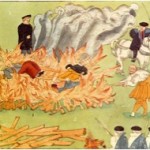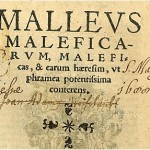Course:ETEC540/2009WT1/Assignments/ResearchProject/UnintendedConsequences
 " class="alignnone" width="350" height="289" />
" class="alignnone" width="350" height="289" />Gutenberg’s printing press, invented in 1440 has been heralded by some as one of the most important inventions of all time. “The invention and development of printing with movable type brought about the most radical transformation in the conditions of intellectual life in the history of western civilization. It opened new horizons in education, and in the communication of ideas. Its effects were sooner or later felt in every department of human activity.”(Gilmore, p. 186) Whether it deserves this status is debatable, but it certainly is what Elizabeth Eisenstein (1979) calls “an agent of change. “ Many including Eisenstein credit the ability to mass produce printed text as being an effective agent of change in the Reformation, the European Renaissance, European nationalism, education, and the advance of science and technology. Francis Bacon said, “ We should note the force, effect, and consequences of inventions which are nowhere more conspicuous than those three which were unknown to the ancients, namely: printing, gunpowder, and the compass. For these three have changed the appearance and state of the world.” (P. 43)
It is not the intent of this paper to look at all the consequences of the printing press, but rather to look specifically at one unintended consequence; the European witch hunts which occurred from the 1400’s to the 1700’s. These witch hunts resulted in the murder of somewhere between 60,000 and 100, 000 people, primarily women who were brutally tortured and then hung or burned at the stake. Although little research on the causes of the witch-hunts has been completed both Eisenstein (1979) and Schlain (1998) contend that although the printing press didn’t cause the witch hunts, it was certainly a major catalyst.
<img src=" " alt="burning witches" title="burning witches" width="150" height="150" class="aligncenter size-thumbnail wp-image-1489" />
" alt="burning witches" title="burning witches" width="150" height="150" class="aligncenter size-thumbnail wp-image-1489" />
A Brief History of the Witch Hunts Prior to the 14th century, witches were not a major concern. There were good witches and bad ones, depending on the type of magic they performed. The users of magic did so to meet mundane human needs with things such as love potions, and fertility rituals. Witches, or more often known as healers, were capable of special actions through the use of spells and potions. These people were viewed at the most as having special powers, but were not considered in a negative light. (Ben- Yehuda, 1980) The official belief of the Catholic Church up and into the 13th century was that witchcraft was an illusion. In 1326 Pope John XXII took the papal seat. He believed in the presence of witches and issued Super illus specular, which acknowledged that magic was real, and a heresy. This gave the inquisitors the power they needed to hunt out and punish witches. Punishment for practicing witchcraft at this time was mild – perhaps a day in the stocks. By the end of the 15th century and for the next 200 years witchcraft would become an “elaborate demonological theology” (Ben- Yehuda, 1980) that captured the interest of not only the clergy and the law, but the general public as well. The last official execution for witchcraft was in 1782.
<img alt="" src=" " class="alignnone" width="500" height="332" />
Factors Influencing the Witch hunts.
" class="alignnone" width="500" height="332" />
Factors Influencing the Witch hunts.
In his concluding discussion, Ben-Yehuda (1980) credits the new goals set by the Dominicans to extend the inquisition to witchcraft, and the massive social upheaval that Europe was experiencing as a result of the both the Reformation, and the renaissance for creating the conditions for the witch craze. Although these are factors that led to and helped sustain the witch craze, I believe he is omitting one of most important factors; the printing press.
Thirty years after the invention of the printing press by Johannes Gutenberg in 1440, two Dominican order inquisitors, James Sprenger, and Henry Kramer wrote Melleus maleficarum or The Witch’s Hammer in order to refute claims that witches didn’t exist. Although this wasn’t the only book about witchcraft published (at least fifteen different books were written (Ben- Yehuda, 1980)) it was certainly the most influential. This book was divided into three parts. The first section provided arguments about the existence of witches, the second was a detailed description on how to identify them and the final section provided information of the legalities of witchcraft and how to sentence witches. Its popularity was almost immediate and was reprinted at least 20 times between 1574 and 1669. (Schlain, 1998) At one point it was only second to the bible in popularity. (Lovelace).
 " alt="male" title="male" width="150" height="150" class="aligncenter size-thumbnail wp-image-1497" />
" alt="male" title="male" width="150" height="150" class="aligncenter size-thumbnail wp-image-1497" />How is it possible that one printed book could be the purveyor of the horrors of the witch-hunts? Ben-Yehuda states “Its enormous influence was practically guaranteed, owing not only to its authoritative appearance but also to its extremely wide distribution.”(p. 11) With-out the printing press the distribution and multiple printings would not have been possible. He also raises another important point-the fact that the book had an authoritative appearance, which was critical for the success of this text.
Europe was in the midst of great social change at this time. The Reformation brought about a challenge to the moral authority of the church. Scientific and technological innovations where changing the way people lived, thought, and worked. People were moving into urban areas, which changed the traditional feudal order and hierarchy. All this change led to social instability and confusion. In a state of upheaval people look for moral guidance and authority to explain what is happening and what can be done about it. Melleus maleficarum offered this moral guidance and authority. Because of its contents, structure and printed form Melleus maleficarum provided a powerful new ideology that people were seeking.
An ideology has several features. It provides an authoritative explanation of events. It contains “suasive images” that have the power to arouse emotions, direct mass action, and a promise that this course will restore the pre-existing situation. (Geertz 1964) Lovelace reminds us that understanding the world according to scientific principal was in its infancy. In an attempt to understand the world, people often accredited unexplainable events to magic. “The Malleus drew upon those beliefs, and, by its very existence, reinforced them and brought them into the codified belief system of the Catholic Church. “ (Lovelace)
It was not just the contents of the book that made it so powerful, but the fact that it was a book was also key. Eisenstien (1979) says “the deep penetration of new controls to all departments of life becomes more explicable when we note that printed books are more portable than pulpits, more numerous than priests, and the messages they contain more easily internalized.” (p. 428) Much of what had been passed down orally was now being recorded in books. Ong (1982) tells us that in an oral culture, information passed along did not have the same permanence as printed text. The information was provided in the here and now and was subject to revision according to the situation. Printed text offered the same information but it was being presented in a new way- one that made it very difficult to ignore or alter. As Eisenstein(1979) tells us, it offered precise rules or codes about how things were to be done. Malleus offered clues to identification of witches. For example the printed texts informed that witches were often older single women with cats. Perhaps before this book was printed, you could choose to ignore this type of gossip, but once it was published, it presented an authoritative voice that one could not ignore. Neighbours and even family members reported one another.
Although the printing press was not the cause of the European witch craze of the 1400 through 1700’s, it was a technology that allowed for the mass production of material that was instrumental in the dissemination of information that fed the witch-hunt craze. The rapidly changing social order, the pressure to control ones behavior, and the major changes that were happening with-in the church were certainly critical factors. Without the printed texts, the witch-hunts would never have been as devastating as they were.
The witch-hunts do not directly affect literacy or education today, but there is a lesson to be learned. Dewar (1998) warns us that many developments have unintended consequences which often dominate the intended ones. Although the Catholic Church may have seen the benefits of the printing of intentions and the bible, it surely didn’t see the unintended consequence; that being the protestant reformation. The witch-hunts are another example of unintended consequences. “ If the future is to be dominated by unintended consequences, it would be a good idea to get to those consequences as quickly as possible….. or you will be overrun.” (p. 25) He goes on to say that if large institutions such as schools and governments choose to deal with inappropriate use through bans and firewalls, they may well find they have a reformation (or witch-hunt)on their hands. One that may have results of which they have no control. It is critical that we stay on top of these things and deal with them quickly in a creative way- not by pretending they don’t exist.
For more information about the witch-hunts view the following video. <object width="425" height="344"><param name="movie" value="http://www.youtube.com/v/TR2dHbA-orw&hl=en&fs=1&"></param><param name="allowFullScreen" value="true"></param><param name="allowscriptaccess" value="always"></param><embed src="http://www.youtube.com/v/TR2dHbA-orw&hl=en&fs=1&" type="application/x-shockwave-flash" allowscriptaccess="always" allowfullscreen="true" width="425" height="344"></embed></object>
Resources
Ben- Yehuda, N. (1980). The european witch craze of the 14th to 17th centuries: A sociologist's perspective. The American Journal of Sociology , 86 (1), 1-31.
Dewar, J. (1998). The Information Age and the Printing Press:Looking Backwards to See Ahead. US: RAND Publications
Eisenstien, E. (1979). The Printing Press as an Agent of Change (Vol. 1). West Hanover, US: Cambridge University Press.
Gilmore, M. P. (1952). The World of Humanism 1453-1517. In E. Langer (Ed.), The Rise of Modern Europe. New York.
Lovelace, W. (n.d.). Malleus Maleficarum Introduction. Retrieved October 2009, from Wicasta's Writing: http://www.wicasta.com/writing /?p=61
Mullins, W. (1972). On the Concept of Ideology in Political Science. The American Political Science Review.
Ong, W. (2002). Orality and Literacy. Great Britain: Routeledge.
Russell, J. (1972). Witchcraft in the Middle Ages. Cornell University Press.
Schlain, L. (1998). The Alphabet Versus the Goddess. US: Penguin Compass.
The Burning Times Documentary Part 5, http://www.youtube.com/watch?v=TR2dHbA-orw&feature=related
